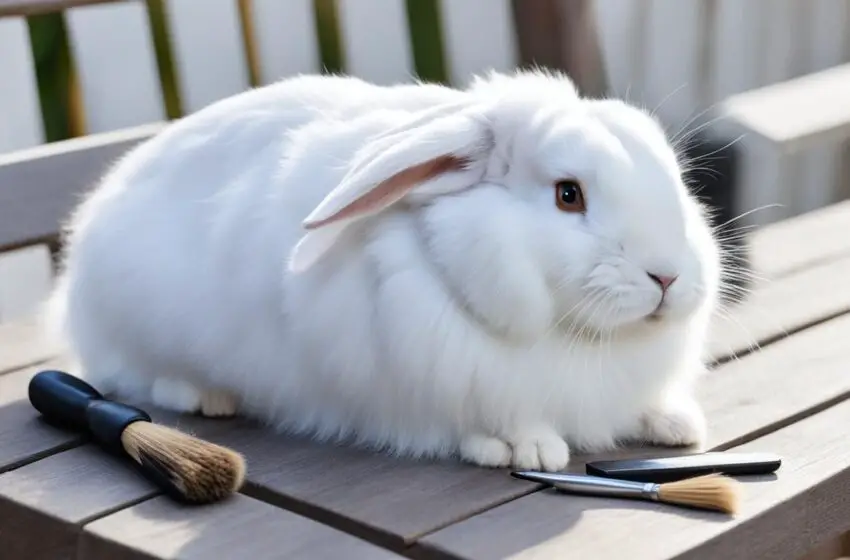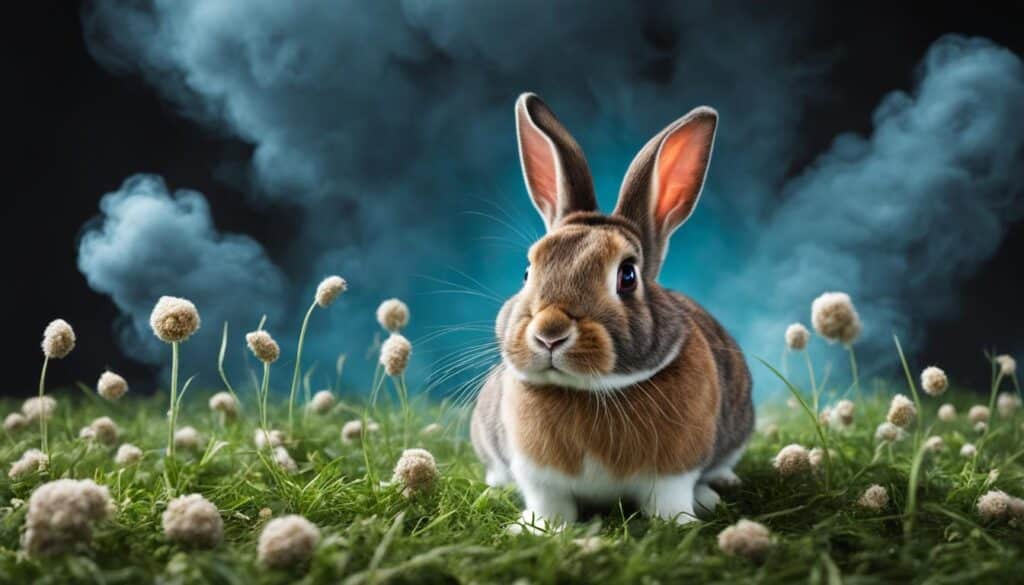Managing Shedding in Pet Rabbits: A Guide

Shedding is a natural process for rabbits to replace their old fur with new growth. By managing shedding effectively, I can help maintain my pet rabbit’s healthy coat and keep my home free of excessive fur. Here are some expert tips to guide me.
Key Takeaways:
- Regular grooming helps remove loose fur and prevent tangles.
- A well-balanced diet with hay and vegetables is essential for healthy fur growth.
- Cleaning regularly and using a vacuum can help maintain a fur-free home.
- Be aware of any shedding-related issues and consult a veterinarian if needed.
- If allergies occur, consider using an air purifier and maintaining cleanliness to minimize exposure to allergens.
Understanding Rabbit Shedding
Rabbit shedding is a natural process influenced by several factors such as breed, age, health, and the molt cycle. It is important for rabbit owners to understand the shedding patterns of their furry companions to provide appropriate care and support during this time. Let’s explore the key aspects of rabbit shedding.
Molt Cycle and Shedding Frequency
Most rabbits experience two major sheds each year, typically occurring in spring and fall. These sheds are often more pronounced and may require extra attention. During shedding periods, rabbits shed their old fur to make way for new growth. It is essential to facilitate this process to prevent fur matting and other related issues.
Special Considerations for Angora Rabbits
Angora rabbits, known for their long, soft fur, have a continuous growth cycle and require specific care during shedding. Their fur continually grows, and as a result, they can experience more frequent shedding. Regular grooming and monitoring is crucial to prevent matting and maintain their luxurious coat.
“Angora rabbits have a unique shedding pattern due to their continuous growth cycle. Regular grooming and maintenance help prevent matting and ensure optimal coat health for these beautiful rabbits.” – Rabbit Care Expert
The molt cycle of angora rabbits is less predictable compared to other breeds. This cycle can be influenced by factors such as nutrition, temperature, and overall health. As responsible owners, it is important to monitor your angora rabbit’s shedding patterns and adjust their grooming routine accordingly.
Grooming Routine for Shedding Rabbits
Establishing a regular grooming routine is essential for managing shedding in rabbits. Brushing your rabbit’s fur with a suitable shedding tool helps remove loose fur and prevent tangles. Depending on the breed and hair length, you may need to groom your rabbit every 1-3 days during shedding periods.
Regular brushing during shedding not only helps control the amount of loose fur in your rabbit’s coat but also prevents the formation of tangles. It is especially important for rabbits with long or dense fur, as they are more prone to matting.
When choosing a shedding tool, opt for one specifically designed for rabbits. A grooming mitt or a soft-bristled brush can effectively remove loose fur without causing any discomfort to your furry friend.
To properly brush your rabbit, start by gently running the shedding tool through their fur in the direction of hair growth. Be careful around sensitive areas like the belly and ears. Use shorter strokes to remove any tangles or knots.
H3: Preventing Tangles
- Use a wide-toothed comb to gently detangle any knots in your rabbit’s fur. Start at the end of the hair strand and work your way up to avoid causing pain or breaking the fur.
- If you encounter a stubborn tangle, you can use a pet-safe detangling spray or a small amount of cornstarch to help loosen the knot.
- Trimming your rabbit’s fur, especially around the rear end, can also help minimize the risk of tangles.
Regular grooming not only benefits your rabbit’s coat but also strengthens the bond between you and your pet. It allows you to check for any signs of skin issues, parasites, or other abnormalities that may require veterinary attention.
| Shedding Routine | Brushing Frequency |
|---|---|
| Short-haired breeds | Every 1-3 days |
| Long-haired breeds | Every 1-2 days |
| Angora rabbits | Every day |
Diet and Nutrition for Healthy Fur
A well-balanced diet plays a crucial role in maintaining your rabbit’s healthy fur. Providing the right nutrition ensures they receive the necessary nutrients for healthy fur growth and supports the shedding process. Here are some key dietary considerations to promote a shiny coat and overall well-being:
1. High-quality Hay:
Hay is an essential component of a rabbit’s diet. It provides necessary fiber, aids in digestion, and promotes dental health. Choose high-quality timothy or orchard grass hay, and ensure it is fresh and free from dust or mold. Provide a constant supply of hay for your rabbit to munch on throughout the day.
2. Fresh Vegetables:
Incorporate a variety of fresh vegetables into your rabbit’s diet to provide essential vitamins and minerals. Leafy greens like kale, parsley, and romaine lettuce are excellent choices. Remember to introduce new vegetables gradually and monitor your rabbit for any adverse reactions.
3. Limited Pellets:
Pellets are a concentrated source of nutrients and should be provided in moderation. Opt for high-quality pellets specifically formulated for rabbits, avoiding those with added seeds, nuts, or sugary ingredients. Offer a small portion of pellets daily, based on your rabbit’s size and weight.
4. Hydration:
Ensure your rabbit has access to fresh, clean water at all times. Use a water bottle or a heavy ceramic dish to prevent spillage or tipping. Regular hydration is essential for overall health and helps maintain the condition of their fur.
Remember, rabbits have sensitive digestive systems, so it’s vital to introduce new foods gradually and monitor their response. Consult your veterinarian for specific dietary recommendations based on your rabbit’s age, breed, and overall health.
| Nutrients | Food Sources |
|---|---|
| Fiber | Timothy or orchard grass hay, leafy greens |
| Vitamin A | Carrots, kale, spinach |
| Vitamin C | Bell peppers, parsley, broccoli |
| Calcium | Kale, dandelion greens, broccoli |
| Protein | Pellets, alfalfa hay (for young rabbits) |
A well-rounded diet consisting of hay, fresh vegetables, and a limited amount of pellets will help maintain your rabbit’s healthy fur and overall well-being. By providing the necessary nutrients, you can support their shedding process and ensure they have a shiny, lustrous coat.
Maintaining a Fur-Free Home
To keep your home fur-free, I recommend incorporating regular cleaning habits. This ensures a clean and comfortable environment for both you and your pet rabbit. Here are some effective strategies:
Vacuuming
One of the most efficient ways to remove stray fur is by vacuuming the areas where your rabbit spends most of their time. Regular vacuuming helps eliminate loose fur from carpets, rugs, and furniture, preventing it from accumulating and causing allergies or discomfort. Remember to pay extra attention to any favorite hiding spots your rabbit may have.
Lint Roller
To tackle fur on clothing and upholstery, using a lint roller can be highly effective. Simply roll the lint roller over the affected surfaces, and the adhesive will pick up the loose fur. This is especially helpful when you’re in a hurry or need a quick touch-up before leaving the house.
Washable Blankets or Covers
Consider using washable blankets or covers on furniture and surfaces that your furry friend frequently uses. These protective layers are easy to clean and can be quickly tossed into the washing machine, reducing the effort required to keep your home fur-free. Additionally, they provide a cozy spot for your rabbit while minimizing the spread of fur onto your furniture or carpets.
“Regular vacuuming and using a lint roller are effective ways to remove stray fur and maintain a fur-free home.”

By implementing these cleaning practices, you can create a fur-free environment that is both aesthetically pleasing and free of potential allergens. Remember, regular cleaning not only keeps your home tidy but also promotes the overall well-being of your pet rabbit.
Recognizing Shedding-Related Issues
While shedding is a normal process, it’s important to be aware of any shedding-related issues in your rabbit. Excessive shedding, hairballs, or signs of skin irritation may indicate an underlying health problem. If you notice any concerning symptoms, consult a veterinarian for an evaluation.
If your rabbit is experiencing excessive shedding, where there is a significant increase in the amount of fur being shed, it could be a cause for concern. Excessive shedding can be a sign of stress, hormonal imbalance, or underlying medical conditions. Keeping track of shedding patterns and noting any notable changes can help identify when shedding becomes excessive.
Hairballs are another shedding-related issue that can affect some rabbits. When rabbits groom themselves, they ingest fur, which can form hairballs in their digestive system. Hairballs can cause discomfort, digestive problems, and even blockages if not addressed. Providing regular grooming and a high-fiber diet can help prevent the formation of hairballs.
Skin irritation is a common issue that can accompany shedding in rabbits. Itching, redness, or sores on the skin may indicate an underlying allergy, parasite infestation, or skin infection. If you notice any signs of skin irritation during shedding, it’s important to seek veterinary advice for proper diagnosis and treatment.
Remember, while shedding is a natural process, it’s crucial to be vigilant and recognize any shedding-related issues that may indicate an underlying health problem in your rabbit. Regular monitoring, grooming, and prompt veterinary care can help ensure your rabbit’s well-being and prevent any complications.
Controlling Rabbit Allergies
If you or someone in your household experiences allergic reactions to rabbit fur or dander, it’s essential to take steps to minimize allergen exposure. Here are some strategies to help you control rabbit allergies:
1. Use an Air Purifier
An air purifier with a HEPA filter can help remove allergens from the air, reducing the risk of allergic reactions. Place the air purifier in the rooms where you spend the most time with your rabbit to maintain cleaner air quality.
2. Keep the Rabbit’s Living Area Separate
Designate a specific area for your rabbit’s habitat and keep it separate from the main living spaces in your home. This can help contain allergens to a specific area and minimize their spread throughout the house.
3. Maintain a Rigorous Cleaning Schedule
Regular cleaning is vital for minimizing allergens. Vacuum and dust your home frequently, paying close attention to areas where your rabbit spends time. Use a vacuum cleaner with a HEPA filter, as it can effectively trap allergens.
“Regular cleaning is essential to minimize the allergens present in your home.” – Dr. Emily Johnson, Veterinarian
In addition to regular vacuuming, consider using a damp cloth or mop to clean surfaces, as it can help capture the allergens instead of spreading them into the air.
It’s also important to wash your rabbit’s bedding and toys regularly to reduce allergen buildup. Use hot water and hypoallergenic laundry detergent when cleaning these items.
4. Minimize Direct Contact
Limit direct contact with your rabbit if you experience allergic reactions. Avoid touching your face after handling your rabbit and wash your hands thoroughly with soap and water. Wearing gloves when handling your rabbit can also help reduce allergen exposure.
Remember to consult with an allergist if you or someone in your household experiences severe allergic reactions to rabbits. They can provide personalized advice and recommend appropriate treatments or medications to manage the allergies effectively.

Common Allergens and their Sources
| Allergen | Source |
|---|---|
| Rabbit Fur | Direct contact with rabbits |
| Rabbit Dander | Shed skin cells of rabbits |
| Dust Mites | Common in household dust and bedding |
| Pollen | Outdoor allergens from plants and flowers |
Conclusion
Managing shedding in pet rabbits is crucial for maintaining their optimal coat health and creating a fur-free environment in your home. By following these expert tips, you can ensure a healthy and happy rabbit.
Regular grooming is essential to remove loose fur and prevent tangles. Establish a grooming routine that includes brushing your rabbit’s coat with a suitable shedding tool. Depending on your rabbit’s breed and hair length, aim to groom them every 1-3 days during shedding periods.
In addition to grooming, provide a well-balanced diet rich in high-quality hay, fresh vegetables, and a small portion of pellets. This ensures that your rabbit receives the necessary nutrients for healthy fur growth and supports the shedding process. Remember to consult a veterinarian if you have any concerns about your rabbit’s shedding patterns or overall well-being.
To maintain a fur-free home, incorporate regular cleaning habits. Vacuum the area where your rabbit spends most of their time and use a lint roller on furniture and clothing to minimize stray fur. Consider using washable blankets or covers on surfaces frequented by your furry friend for easy cleaning.
By implementing these practices, you can effectively manage shedding in your pet rabbit, promote optimal coat health, and create a fur-free environment that both you and your rabbit will appreciate.
FAQ
When do rabbits shed?
Most rabbits experience two major sheds each year – in spring and fall. However, the shedding process can also be influenced by factors such as breed, age, health, and the molt cycle. Angora rabbits, for example, have a continuous growth cycle and require extra attention during shedding.
How often should I groom my rabbit during shedding?
Depending on the breed and hair length, you may need to groom your rabbit every 1-3 days during shedding periods. Establishing a regular grooming routine and using a suitable shedding tool to brush your rabbit’s fur will help remove loose fur and prevent tangles.
What should I feed my rabbit to promote healthy fur growth?
A well-balanced diet is crucial for maintaining your rabbit’s healthy fur. Provide them with high-quality hay, fresh vegetables, and a small portion of pellets to ensure they receive the necessary nutrients. Proper nutrition supports the shedding process and promotes a shiny coat.
How can I keep my home fur-free?
Incorporating regular cleaning habits can help keep your home fur-free. Vacuum the area where your rabbit spends most of their time and use a lint roller on furniture and clothing to reduce the presence of stray fur. Consider using washable blankets or covers on surfaces frequented by your furry friend.
What should I do if I notice excessive shedding or other issues?
While shedding is a normal process, excessive shedding, hairballs, or signs of skin irritation may indicate an underlying health problem. If you notice any concerning symptoms, it is recommended to consult a veterinarian for an evaluation and appropriate advice.
What can I do to control rabbit allergies?
Some individuals may develop allergies to rabbit fur or dander. If you or someone in your household experiences allergic reactions, consider using an air purifier, keeping the rabbit’s living area separate, and maintaining a rigorous cleaning schedule to minimize allergen exposure.
How can I ensure optimal coat health for my rabbit?
By following these tips for managing shedding in pet rabbits, you can help ensure optimal coat health and create a fur-free environment in your home. Regular grooming, a nutritious diet, and maintaining cleanliness are key practices to promote a healthy and happy rabbit. Remember to seek veterinary advice if you have any concerns about your rabbit’s shedding patterns or overall well-being.



